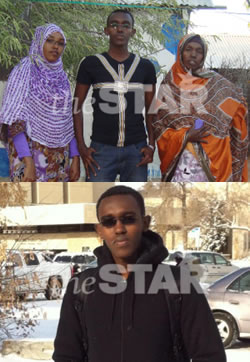
Tuesday, February 18, 2014
He is now an Electrical Engineering student at the University of Saskatchewan in the beautiful city of Saskatoon, Canada.
"It was not an easy journey," he says with a radiant smile, proud that he had beaten all the odds to reach where he is today.
Mohamed was born in Mogadishu, the capital of Somalia, on a fine Sunday evening in 1988, a few years before the country fell on its knees, and when Somalia still lived in concord with its neighbouring states.
Mohamed was not considered fit to pursue secular education until May 29, 2000 when he had completed learning the Quran and the Basic Principles of Islam under the tutelage of his father.
 |
However, Mogadishu was then in turmoil. Men were killed, women were raped and children were maimed by fierce warlords who had no respect for humanity. Homicide and the public property embezzlement were the order of the day. Sometimes there was a heavy shooting around the school and children were released from school. But life had to go on. Children still had to go to school.
Despite the problems at home and the war in the country, Mohamed showed a strong determination to learn. He struggled to learn how to read and write. There was no one at home to help him with the homework. So he had to be attentive in class in order to be ahead of the other children.
A few months later, when he sat for his first examination, Mohamed was ranked top his class - a position he held until he completed high school.
Forced to Flee
Many years have passed. Now Mohamed was in Form Two. But life in Mogadishu was unbearable, and the family decided to flee. The Islamic Courts Union, which would later change its name to al Shabaab, was fighting the warlords who ousted the Siad Barre regime in 1991.
On April 15, 2006, Mohamed parted from his childhood friends and waved goodbye to the only city he had known, and the family fled to Kenya to embrace a future hidden in the horizons.
The journey was terrible. They had to walk on foot for 1,500km in a busy, lion-infested desert for 15 days until they arrived at Hagadera, one of the refugee camps that make up the Dadaab Complex in North Eastern Kenya.
Life in the camp was equally hard. The family had to depend on little food that was provided by the United Nations World Food Programme. The temperatures in the camp would sometimes hit 40 degrees Celsius and the children were stricken by malaria and other diseases yet there was no medicine available.
But there was free education in Dadaab and therefore Mohamed again had the opportunity to go to school.
"I saw a bright light at the end of the dark tunnel," he says.
Then another problem arose. The Ministry of Education in Kenya does not recognise certificates from schools in Somalia, despite them having been signed by Unesco. So Mohamed had to start from Standard Seven. And another journey started.
A Series of Blessings
Mohamed started to lead his class although his new classmates were very bright, and the competition stiffer than when he was back in Mogadishu.
Halimo Saman,a fresh high school graduate and a primary teacher, motivated Mohamed to work hard in school in order to get away from the hard refugee life.
Halima had performed well in high school and was waiting for a scholarship to Canada. Mohamed therefore vowed to emulate her. He buried himself in books and slept late at night.
A year later, when he sat for the KCPE examination, Mohamed was the best student in the entire Dadaab region. He attained 394 marks out of the possible 500.
"The then Education Minister, Prof George Saitoti, announced my name," he says with a broad smile.
Mohamed got a scholarship to study at Starehe Boys Centre in Nairobi. But there was unrest in the country following the 2007-08 post-election violence, and because of the insecurity, elders from Dadaab dropped his scholarship.
However, Mohamed did not give up. He joined Hagadera Secondary School, and in the 2011 KCSE examination, he again led the entire Dadaab region with an A-Minus of 78 points, a record that still remains unbroken.
There was no university or college in Dadaab at the time. But there is the famous World University Service of Canada (WUSC) scholarship programme, run by a Canadian group and facilitated by Windle Trust Kenya.
WUSC is for refugee students, both in Dadaab and Kakuma, who attain an average of 60 points (B) for boys and 46 points (C+) for girls.
Early 2012, Mohamed was selected for the WUSC scholarship whose process takes 18 months. He was teaching Physics in Waberi Secondary School until August 2013 when he left for Canada, leaving behind his parents, two brothers, a sea of friends and a few hundreds of his students.
At midnight, August 28, 2013, Kenya Airways took off from Jomo Kenyatta International Airport and left with the teacher and the role model of many students in Dadaab.
Flying through London and Toronto, Mohamed, popularly known as M Square, landed safely on his final destination and was welcomed by fellow students with banners reading: ‘Welcome Mohamed! Welcome to Saskatoon Shines!'
And his role model, Halima Saman, who also lives in Saskatoon, called him to confirm whether he had arrived safely. Only then did he realise that his dream had come to pass.
Source: The Star